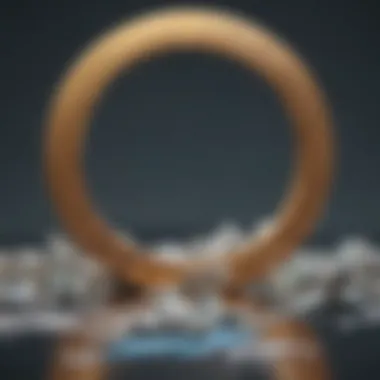Art as an Investment: Merging Creativity and Finance


Intro
Art has often been perceived as primarily a realm of aesthetics, and while this remains true, its function has evolved significantly over time. More than just a visual spectacle, art possesses characteristics akin to traditional investment vehicles, offering a unique avenue for diversifying one's portfolio. As financial markets fluctuate and economic uncertainty looms, many investors are increasingly turning their gaze toward the canvas and sculpture as a viable alternative for investing.
In this exploration of art as an investment, we delve into not only the historical context that shapes its value but also the intricate dynamics that govern its recognition in the financial sphere. Elements such as provenance, artist reputation, and market demand play pivotal roles in determining how much a piece may appreciate.
Moreover, understanding the psychology behind art ownership adds an emotional layer often overlooked in conventional investing. Investors are not merely accumulating assets; they are engaging with culture, history, and personal expression. This engagement often guides their investment decisions as much as, if not more than, the actual financial returns.
Whether you are an astute financial advisor, a novice collector, or trying to make sense of new trends in art investment, this discourse aims to illuminate key concepts and strategies. By examining the various dimensions of art as financial investment, we will help the reader navigate this complex landscape with confidence and discernment.
Understanding Alternative Investments
In the current financial landscape, the concept of alternative investments has gained a lot of traction, especially among investors looking to diversify their portfolios beyond traditional assets like stocks and bonds. This section aims to clarify the role of alternative investments, particularly focusing on how art fits into this dynamic.
Engaging with alternative investments allows individuals to mitigate risk and tap into unique opportunities for value appreciation, often not correlated with mainstream market movements. Art, as an asset class, presents a compelling option for those willing to explore its complexities.
Consider the benefits of blending traditional and alternative investments. For instance, art has the potential to appreciate significantly over time. Not only does it bring aesthetic enjoyment, but it can also serve as a store of value, much like real estate. The global shifts in wealth and economic conditions have led many investors to look at art as part of a diversified investment strategy.
What sets alternative investments apart is their inherent risk and return profile. While stocks might give an investor the jitters during market downturns, a well-chosen piece of art may retain or even increase in value. This poses a compelling argument for including such assets in one's portfolio.
Defining Alternative Investments
Alternative investments refer to asset classes that fall outside the conventional realms of stocks, bonds, and cash. These can include real estate, hedge funds, private equity, and, notably, art and collectibles. The defining characteristic of alternative investments is their non-traditional approach to generating returns, often incorporating unique valuation metrics and less liquidity compared to stocks and bonds.
Investors might gravitate toward art as an alternative asset due to its tangible nature and the emotional connection it often evokes.
In many cases, the value of art is subject to subjective interpretation and heavily influenced by factors like the artist's reputation, market demand, and provenance. This brings an added layer of complexity but also allows for outsized returns when the right pieces are acquired at the right time.
Some examples of alternative investments include:
- Art: Contemporary pieces, classical works, or emerging artists.
- Wine: Fine wines can appreciate in value similar to art.
- Collectibles: Stamps, coins, and sports memorabilia often attract dedicated investors.
- Cryptocurrency: Has emerged as a modern alternative investment with high volatility.
The Evolution of Investment Strategies
Over the years, investment strategies have evolved significantly. Traditionally, people relied on easygoing investments like bonds and mutual funds, considering them safe. However, with the advent of technology and a volatile economy, investors began looking for ways to break free from the norm.
This transformation led to a broader acceptance of alternative investments. The rise of online auctions and platforms has also democratized access to art, making it easier for budding investors to enter the market.
Investing in art no longer means needing deep pockets. With mid-range artists gaining popularity and online galleries flourishing, it’s become feasible for more than just wealthy collectors to build art portfolios.
Furthermore, as the global economy fumbles through uncertainty, alternative investments have started attracting attention as a hedge against inflation and market volatility. In recent years, there’s a growing acknowledgement of not just alternative investments, but of the unique intersection where creativity meets finance.
Art and finance are not so incompatible. Instead, they create a tapestry of value, intricacy, and unexpected opportunities.
The Art Market Landscape
The landscape of the art market is a complex, often overlooked arena where creativity and finance coexist in a delicate balance. Understanding its framework is crucial for anyone interested in art as an alternative investment. Unlike traditional stocks and bonds, the art market presents its own unique dynamics that require a nuanced approach and an appreciation for both the aesthetic and economic value of art pieces.
In a world increasingly valuing diversifying one’s portfolio, the art market stands out as an appealing option. Collectors and new investors alike can find themselves drawn not just by the allure of art itself, but by the potential financial benefits associated with it. Furthermore, it serves as a cultural barometer, reflecting shifts in societal values and trends. The interplay between market forces, art movements, and individual tastes creates an evolving tapestry that savvy investors must navigate.
Historical Context and Development
The evolution of the art market is rooted deeply in history. In ancient times, art was often a patronage affair, primarily commissioned by the wealthy elite. Over centuries, this shifted toward a broader commercialization, paving the way for today’s global market. A look back reveals various significant checkpoints, such as the rise of galleries in the 19th century and the establishment of auction houses that further changed how art was bought and sold.
As artistic movements came and went—from the Renaissance to Modernism—they shaped the demand for various artworks. Each era had its characteristics and notable artists, creating a ripple effect that influenced collectors, dealers, and investors. The increased accessibility in recent decades, owing to online platforms, has opened up new frontiers for purchasing art, making it vital for investors to remain aware of both historical trends and contemporary shifts.
Key Players in the Art Market
The art market is not a monolith; it comprises various key players that each fulfill a unique role in this intricate ecosystem. Understanding these roles can provide insights into effective investment strategies.
Galleries and Dealers


Galleries and dealers are often the first contact point for new and seasoned collectors alike. They play a pivotal role in showcasing artists' works and helping define their market value. Most galleries focus on specific niches, whether it be contemporary art or historical pieces, allowing them to curate collections thoughtfully.
The key characteristic of galleries is their relationship with artists—representing them, promoting their work, and often guiding collectors in art selection. They can be a beneficial choice for investors because they usually provide insights into an artist's career trajectory and long-term potential.
Nonetheless, there are notable disadvantages. For instance, the margins in gallery sales can be steep, and collectors may find themselves navigating the relationships between artists and dealers, which can lead to challenges in transparency. However, the unique feature of galleries often lies in their ability to provide personalized advice, helping collectors make informed decisions.
Auction Houses
Auction houses bring a different flavor to the art market. Platforms like Sotheby’s and Christie’s facilitate high-profile sales that not only set benchmarks for prices but also generate considerable media buzz. Their significance lies in creating a marketplace driven by competitive bidding, allowing art to achieve its highest potential value through public interest.
The key characteristic of auction houses is their ability to attract serious collectors and investors, making them a popular choice for high-value transactions. They also host thematic sales, which can spotlight emerging artists alongside established names, aligning with broader trends in the art world.
However, auction houses come with their own set of unique features, such as hefty commission fees and often a lack of transparency concerning pricing history. This can make for a more daunting experience for new investors who may feel overshadowed by seasoned bidders.
Collectors and Investors
Collectively, collectors and investors are the lifeblood of the art market. They not only fund artists and galleries through their purchases but also influence market trends with their buying patterns. Whether motivated by passion or profit, they hold significant sway over which art pieces are seen as valuable.
The key characteristic of collectors is their diverse motivations—some collect for personal enjoyment, while others view it strictly as an investment. Understanding this duality makes them a beneficial choice for the market, since it fosters both appreciation and speculation.
One unique aspect of this group is that they often create communities, supporting one another through shared interests, and sometimes even pooled resources. This camaraderie can lead to advantageous opportunities for upcoming artists or emerging trends that investors could capitalize on before they go mainstream.
However, the emotional connections may lead some collectors to make impulsive purchases that lack sound financial judgment. Thus, while the passion for collecting can drive the market forward, it also underscores the importance of balanced perspective when integrating art into investment portfolios.
Understanding the nuances of galleries, auction houses, and collectors equips investors with the tools needed to navigate the art market successfully, highlighting both the opportunities and challenges inherent within this intriguing intersection of creativity and finance.
Factors Influencing Art Value
The value of art is a complex tapestry woven from numerous threads. Understanding the factors that influence this value is crucial for anyone looking to navigate the art market. Unlike traditional investments that might hinge on straightforward metrics, art relies on a mix of subjective perception, historical significance, and market dynamics. Grasping these elements can add a layer of sophistication to an investor's strategy.
Provenance and Authenticity
Proof of an artwork's provenance is often regarded as a golden ticket in the art world. This term refers to the history of ownership of an artwork, detailing where it has been and who has held it over the years. When an artist's piece can be traced back through a credible lineage, it often commands a higher price. Think of it this way: an artwork lacking a solid provenance may as well be a ghost – its history unknown, and likely its worth diminished.
Authentication is equally paramount. In an era where reproductions and forgeries might sneak into galleries or online auctions, due diligence becomes essential. Collectors and investors must ensure that what they are purchasing is genuine. A legitimate certification from recognized institutions can act like a seal of quality, helping to shore up value in a fickle market.
Artist Reputation and Market Demand
The artist behind a piece can significantly impact its value. Well-established artists, such as Pablo Picasso or Andy Warhol, tend to fetch higher prices due to their storied careers and widespread recognition. Potential buyers often weigh an artist's reputation like gold on a scale, assessing not just past pricing but future potential based on current trends and historical significance. Collectors often follow the buzz surrounding emerging artists, hoping to get in early before the prices start to skyrocket.
Market demand plays its part too. If a particular artist or style falls into favor, the value of their works can experience a meteoric rise. Conversely, changing tastes can just as easily lead to a fall from grace. It’s somewhat like the fashion industry – what’s chic today might be dismissed tomorrow. Understanding the ebb and flow of artistic trends helps investors make informed decisions, ensuring they’re not left holding the bag when a style loses its luster.
Cultural and Economic Influences
Art does not exists in a vacuum; it is deeply intertwined with cultural narratives and economic trends. A wax and wane of economic health directly correlates with art sales. During boom periods, disposable income tends to rise, leading to increased purchases of luxury items, art included. Conversely, in times of financial strife, art sales can tumble, causing even the most sought-after pieces to struggle for buyers.
Culturally, global events can dramatically reshape art's landscape. Art movements often emerge in response to societal issues or technological advancements, reflecting the zeitgeist. For example, the rise of digital art amidst the tech boom has opened new avenues for investment but comes with its own set of challenges.
"Art reflects the times; invested wisely, it can be a window to the past and a door to future growth."
At the intersection of culture and economy lies an artist’s ability to capitalize on societal needs or movements, which can amplify their market presence. As a result, savvy investors often keep an ear to the ground, attuned to cultural shifts and economic signals that could affect their investment choices in the art realm.
Investment Strategies in Art
Investing in art is not just about acquiring beautiful pieces to hang on your wall; it has become a serious financial consideration within the realm of alternative investments. The strategies surrounding art investment deserve attention because they can significantly influence overall performance in a diversified investment portfolio. Art offers unique advantages, from passion-driven acquisitions to significant returns on investment. However, one must navigate the maze of personal preferences, market tendencies, and economic climate when engaging in this form of investment.
Collecting for Pleasure vs. Investment
When individuals step into the art world, they often face a dilemma: should they collect primarily for pleasure or with an investment mindset? Collecting for pleasure brings joy and personal fulfillment. The emotional connection to each piece can enrich a collector's life, creating an intimate relationship with art. But if you plan to enter the market with investment goals, it requires a different perspective.
Investors must research trends, artists, and art movements to determine what holds value in the long run. Emotional satisfaction might lead to impulse purchases, while strategic investment may mandate a cool head. This tension often surfaces in discussions among collectors who love the thrill of acquiring works that align with their tastes, yet simultaneously brace themselves for potential changes in market appeal. Balancing these two aspects is essential; someone might enjoy an artwork where colors speak to them, but if there’s no longevity or rising value, it becomes a hobby instead of an asset.


Diversifying with Art
For many investors, diversification is the name of the game. They spread their investments across various asset classes to mitigate risk, and this includes art. Art can be an excellent tool for diversification, acting independently from traditional equities and bonds. The art market often behaves differently from conventional markets, making it a refuge during economic downturns.
Adding art to a portfolio may bring some unique benefits:
- Tangible Asset: Unlike stocks, which are abstract in nature, art is a physical object that can be appreciated for its aesthetic quality.
- Potential for High Returns: While not as liquid as stocks, the right piece of art can see exponential value growth over the years.
- Passion Investment: Collecting art isn't purely numbers; it’s also about passion and culture, leading to more engaged and informed investment choices.
Incorporating art as a strategic asset requires understanding not just the aesthetics but also where the market is headed. A versatile approach will surely yield the best returns.
Long-term Appreciation vs. Short-term Flipping
The dilemma of timing arises when discussing art investment. Some investors aim for long-term appreciation, holding pieces for several years, betting on the gradual increase in value fueled by cultural relevance and historical significance. Others might lean towards a flipping strategy, buying art not for love but for profit, trading in and out based on trends and opportunities.
Long-term appreciation lets an investor weather the storms of market volatility. While it requires patience, it allows one to enjoy the art and potentially see large returns as the creator's reputation develops over time. This strategy often favors works by established artists who have a track record of increasing values.
In contrast, short-term flipping can yield quicker returns but is fraught with risks. Art market trends can shift on a dime, and predicting which pieces will rise quickly can be hit-or-miss. Investors must remain vigilant about current market fluctuations, social influences, and trends in artist popularity.
"Investing in art requires a blend of passion and pragmatism. Ensure your portfolio reflects both your taste and your financial goals."
As art investment strategies become more nuanced, recognizing the nuances between collecting for appreciation and securing quick profits becomes imperative for savvy investors. The landscape of art investing is filled with both opportunity and risk, and personal strategy must align accordingly.
Risks of Art Investment
Investing in art, while alluring, carries its own batch of risks that potential investors cannot afford to overlook. These risks can be multifaceted, affecting not only the value of the artwork but also the investor's peace of mind. Understanding these risks is vital for creating a strategy that protects one’s investment. It’s crucial to be aware that unlike traditional investments such as stocks or bonds, the art market can appear to be an unpredictable roller coaster. Investing in art blends aesthetics with finance, but missteps can lead to unexpected financial pitfalls.
Market Volatility
Art market trends can shift like the wind, often swayed by cultural movements, economic conditions, or even celebrity influence. One moment a certain artist may be all the rage, and the next they're barely mentioned. For example, during the 2008 financial crisis, the art market experienced a noticeable dip, with auction houses reporting significant declines in sales. Understanding that art as an investment is not immune to market ebb and flow is essential.
There are factors that contribute to market volatility, such as:
- Economic downturns that affect discretionary spending.
- Changes in art trends and tastes, influenced by social media and cultural shifts.
- The emergence of new artists that can enhance competition in the market, impacting the value of existing works.
- International events and regulations that may alter the desirability of certain art pieces.
Investors must be prepared for these fluctuations, recognizing that market dips may create both risks and opportunities for savvy stakeholders willing to ride the storm.
Legal and Regulatory Risks
Art ownership is not all about passion and appreciation; there’s also the legal side to consider. Legal and regulatory risks can arise from various scenarios, leading to potential financial loss or, worse, legal entanglements. One primary concern is provenance, which is the documentation verifying an artwork’s history. An unclear provenance can throw a wrench in the works, making it difficult to sell or, worse yet, leading to claims of theft or fraud.
Some other legal considerations to keep in mind include:
- Authenticity issues: Fakes and forgeries can surface in the market, complicating ownership and valuation.
- Cultural property laws: Certain countries have regulations protecting national treasures, which can affect export and ownership rights.
- Tax implications: Artists and investors must abide by tax laws on art sales, which can vary by jurisdiction.
Investors should do their due diligence, ensuring that any artwork's title is free from disputes to avoid sinking into unexpected legal issues.
The Challenge of Liquidation
Selling art is often more complex than meets the eye. Unlike stocks or bonds that can be sold nearly instantly, liquidating art can take considerable time, effort, and sometimes a bit of luck. When someone decides to sell a piece, they may find themselves facing several hurdles.
- Finding the right platform: Whether through auctions, galleries, or online marketplaces, each avenue comes with its own set of challenges and fees.
- Timing the market: Just like real estate, art may not be the most liquid asset. If market conditions aren't favorable, it might not be easy to offload pieces for a desired profit.
- Pricing: Establishing a price point that reflects current demand without undervaluing the artwork can be tricky, often requiring expert input.
Thus, investors must be prepared for the long game when it comes to selling their art investments, knowing liquidity issues may play a significant role in their overall investment strategy.
"The world of art investment is not merely about buying and selling; it’s a delicate dance where art, finance, and emotions converge."
This section lays out the inherent risks in art investment, painting a clear picture of why understanding these risks is paramount for savvy investors. Those with a grasp on these aspects are likely to navigate the art market with a more seasoned hand, reducing the chances of falling into common pitfalls.
The Emotional Aspect of Art Ownership
Investing in art isn’t solely about numbers and market trends; it dances along the realm of emotions. When one collects a piece of art, it often transforms from a mere investment into a personal treasure—a story told through brushstrokes or sculpted forms. The emotional ties that bind investors to their collections can profoundly influence both decision-making and financial returns, making this section essential to understanding the broader picture of art as an alternative investment.


The Psychological Value of Art
Art possesses a unique psychological value that transcends its monetary worth. Owning a piece can evoke joy, inspire creativity, or even serve as a form of self-expression. The power of art to affect mood and foster a sense of identity cannot be overstated. It’s not just a statistic; it’s a connection. Investors often find themselves deeply attached to their choices, where a piece might remind them of a memory or resonate with their personal philosophy.
Moreover, during particularly tumultuous times, art can provide a sense of stability. For example, in economic downturns, while the stock market trembles, a cherished artwork can offer solace. Many psychological studies show that visual stimuli can evoke emotions, triggering dopamine responses that can uplift spirits. Investing in art thereby becomes a dual path—both financially savvy and emotionally fulfilling.
"Art is not what you see, but what you make others see."
– Edgar Degas
Art as a Legacy
The notion of art as a legacy expands the emotional significance of ownership. It’s not just about acquiring art for oneself; it’s also about the imprint one leaves on future generations. A well-curated collection can tell a family’s story, embody values, and evoke memories long after the original owner has passed on. This concept is particularly poignant in many cultures, where art is seen as a vessel that connects generations.
When an investor buys a significant piece, they’re not just tapping into a current trend—they could be laying down a foundation for their heirs. For instance, a family heirloom painting can serve as both a financial asset and an emotional bond that reinforces a family's history and identity.
Thus, art can become a vessel of values, bridging the gap between the past and the future while also instilling a sense of pride. It becomes more than investment; it morphs into a heritage. Many collectors aspire to pass down their favorite pieces, ensuring their appreciation endures through time.
Technological Innovations and Art
Technology has reshaped numerous industries, and the art world is no exception. With the advent of new tools and platforms, investors and collectors alike find themselves in an ever-evolving landscape. The transformation not only increases access but also alters how art is created, bought, and sold. This section delves into two significant advancements: Digital Art and NFTs, alongside the rise of online marketplaces that are challenging traditional auction houses.
Digital Art and NFTs
Digital art has blossomed into a recognized genre, allowing creators to leverage technology for expressive means. Unlike traditional mediums, digital art facilitates an unlimited palette of possibilities, from animated pieces to immersive virtual experiences. The rise of Non-Fungible Tokens (NFTs) has taken the art world by storm, introducing a new frontier for ownership and value.
NFTs represent a unique digital certificate of authenticity stored on a blockchain, validating the originality of a digital piece. This addresses the longstanding issue of reproduction in the digital age. Unlike printed art, which can be endlessly replicated, NFTs ensure that one ownership is traceable and exclusive. Investors are turning to NFTs not just for appreciation in value, but also for the cultural shift they signify.
However, it's essential to navigate the market cautiously. Collectors should ask themselves:
- What makes a particular NFT unique or valuable?
- Are there legalities linked to this digital ownership that one must be apprised of?
While the potential for returns can be sizable, the volatility and lack of regulation present substantial risks. Layering this complexity is the ongoing debate over the environmental impacts of blockchain technologies, particularly related to energy-intensive processes.
"The emergence of NFTs has revolutionized the art market, offering artists new revenue streams while challenging traditional concepts of ownership and replication."
Online Markets vs. Traditional Auctions
The rise of online platforms has transformed the way art is traded. Websites like Artsy, Saatchi Art, and Paddle8 have emerged, presenting a virtual alternative to the hallowed halls of Sotheby’s and Christie’s. For investors, these online marketplaces lower barriers for entry, allowing easier access to curated collections from diverse artists across the globe.
Some advantages of online art markets include:
- Broader access to a global audience, increasing the potential for sales.
- Lower overhead costs compared to physical auction houses.
- The convenience of purchasing art from the comfort of home, often at competitive prices.
Yet, traditional auctions still maintain a certain cachet. Their long-standing reputation offers a level of assurance that some online platforms might lack. There exists an allure tied to attending an auction, with the thrill of bidding providing a unique experience. Often, traditional auction houses also assure buyers of provenance and authenticity, which can be crucial for high-value investments.
Investors face the choice of utilizing online platforms or sticking with traditional methods. Factors to consider include:
- The credibility of the seller.
- The reputation of the platform for handling disputes or issues.
- The expected resale value in a burgeoning or traditional market.
By understanding these shifts in the art landscape, investors can better navigate the opportunities presented by technological innovations. This understanding not only impacts purchasing strategies but also informs broader perceptions of art as an asset class.
Finale and Future Outlook
The exploration into art as an alternative investment reveals a fascinating blend of creativity and finance. As the art market evolves, so do the perceptions surrounding art pieces as valuable assets. Understanding how this landscape has shifted is vital for savvy investors who wish to navigate through the nuances of art investment.
The Changing Perception of Art as an Asset
In recent years, the stigma that once enveloped art as an impractical investment has begun to lift. Art is now being viewed not just as a pastime for the affluent but as a legitimate avenue for wealth accumulation. Investors, both novice and experienced, have begun to recognize that artwork can appreciate significantly, sometimes outperforming traditional investment avenues like stocks or real estate.
This change in mindset can be traced back to various societal shifts: globalization has expanded access to art markets, bringing forth diverse forms of art—all of which can command premium prices. Moreover, as technology enables more transparent pricing and ownership verification, the barriers for entry have lowered. Investors feel more confident in their acquisitions, leading to a flourishing market where both modern and classical pieces hold merit.
Key Takeaways for Investors
- Research and Knowledge: One cannot underestimate the power of understanding the artists, movements, and historical contexts before venturing into art purchases. Knowledge truly is power, especially in a market driven by trends and emotional connections.
- Diversification of Portfolio: Including art in an investment strategy can help mitigate risks associated with more traditional investments. Just as one might diversify with stocks or bonds, incorporating art adds a unique dimension to a financial portfolio while opening up avenues for potential appreciation.
- Emotional Returns Matter: Investing in art is not merely about financial gain; the emotional connection to the pieces often adds an intangible value. Smart investors recognize that the joys of ownership can coexist with financial benefits.
- Stay Attuned to Market Trends: The art market is influenced by broader economic factors. Bearing this in mind, being aware of global trends, market sentiments, and even cultural discussions can empower investors to make informed decisions.
"Art is not what you see, but what you make others see." — Edgar Degas
By processing these insights, investors position themselves better to harness the potential that art offers. As the conversation around art as an asset continues to develop, staying adaptable and informed will be key for anyone looking to carve out a niche in this evolving arena.







